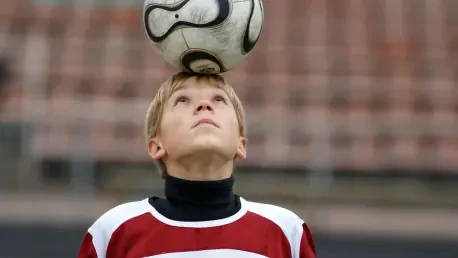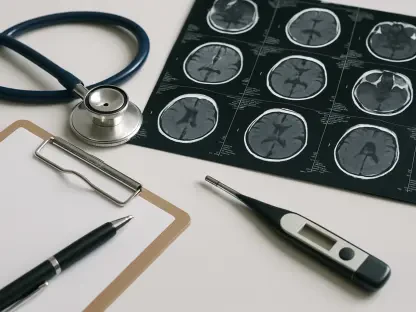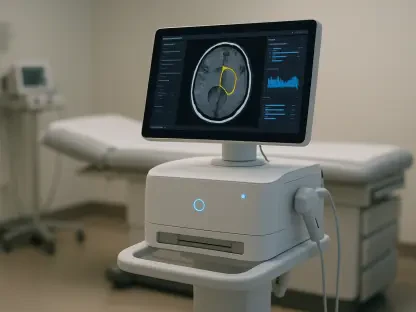Soccer, long considered a safer alternative to high-impact sports like football, hides a significant neurological risk that has recently come under scrutiny, prompting serious concern within the sports community. A groundbreaking study from Columbia University, published on September 18 in JAMA Network Open, has uncovered alarming evidence that repetitive heading—striking the ball with the head—can cause substantial damage to a critical brain region responsible for thinking and memory. Conducted on amateur adult soccer players, this research employs advanced imaging technology to detect subtle, cumulative injuries that might otherwise go unnoticed. The findings challenge the perception of soccer as a low-risk sport and raise pressing concerns about the safety of a fundamental technique practiced by millions globally. With players of all ages and skill levels engaging in heading, the implications of this study are far-reaching, prompting a reevaluation of how the game is taught and played to protect athletes’ long-term health.
Uncovering the Brain’s Vulnerable Spot
The Columbia University study zeros in on the orbitofrontal cortex, a brain area just behind the forehead that plays an essential role in cognitive functions such as decision-making, problem-solving, and memory retention. Unlike the dramatic concussions often seen in contact sports, the damage from soccer heading stems from frequent, minor impacts that accumulate over time. These repeated strikes generate shear forces at the interface of the brain’s gray and white matter, leading to microstructural disruptions that impair normal brain activity. This discovery is significant because it highlights how even seemingly harmless actions on the field can have serious neurological consequences. By identifying this specific region as a primary target of injury, the research provides a crucial starting point for understanding the broader impact of heading and underscores the need for targeted protective measures to safeguard players from unseen harm.
What makes the orbitofrontal cortex particularly susceptible to damage from heading? The answer lies in its unique position at the boundary between gray and white matter, tissues with differing densities that react differently to impact. When a player heads the ball, the resulting forces cause these layers to shift against each other, creating a strain that blurs their normally distinct separation. The study describes this “fuzziness” as a measurable biomarker of injury, revealing how repetitive, low-intensity hits can erode the brain’s structural integrity over time. This vulnerability is not just a theoretical concern but a tangible risk, as the damage in this area directly correlates with diminished cognitive abilities. Understanding this mechanism offers a clearer picture of why heading poses such a threat and emphasizes the urgency of addressing this issue in a sport played by countless individuals worldwide, from casual enthusiasts to aspiring professionals.
Cognitive Risks Tied to Frequent Heading
One of the most striking revelations from the study is the direct connection between the frequency of heading and a decline in cognitive performance. Amateur soccer players who reported heading the ball more than 1,000 times in a single year demonstrated significantly poorer results on tests assessing learning and memory compared to peers with minimal heading exposure. This measurable impairment isn’t merely an abstract finding; it reflects a real loss of mental acuity that can affect how players process information and react during games. The correlation between the extent of heading and the severity of cognitive deficits paints a sobering picture of the risks embedded in a routine aspect of soccer. Such evidence compels the sports community to reconsider the emphasis placed on heading, particularly in training regimens where repetitive drills might unknowingly heighten the danger to players’ brain health over extended periods.
The repercussions of these cognitive deficits extend far beyond the soccer field, influencing various facets of daily life. Difficulties with memory or decision-making can hinder performance at work, strain personal relationships, and diminish overall quality of life for affected individuals. This broader impact suggests that the consequences of heading are not confined to athletic performance but can permeate everyday activities, making it a public health concern as much as a sports safety issue. The study’s focus on amateur players further amplifies its relevance, indicating that even those who play recreationally are not immune to these risks. This finding serves as a wake-up call for coaches, parents, and governing bodies to rethink how heading is introduced and practiced, especially among younger players whose developing brains may be even more susceptible to long-term damage from repetitive impacts.
Advancements in Detecting Hidden Brain Injuries
A pivotal element of this research is the innovative use of brain imaging technology to uncover damage that traditional methods often overlook. Standard diffusion MRI techniques struggle to accurately assess the brain’s outer layers, where heading-related injuries predominantly occur. However, the Columbia team, led by graduate student Joan Song, developed a novel approach to analyze the interface between gray and white matter with unprecedented precision. This method revealed a blurred transition in frequent headers, serving as a clear indicator of microstructural injury. Such a breakthrough not only enhances the ability to detect subtle brain damage early but also provides a deeper understanding of how repetitive impacts affect neurological structures. This advancement marks a significant step forward in sports medicine, offering hope for better diagnostic tools that could ultimately help prevent severe outcomes for athletes across various disciplines.
The implications of this cutting-edge imaging technology extend beyond immediate detection, paving the way for future research and intervention strategies. By providing a reliable means to identify biomarkers of injury, this approach enables scientists to study the progression of brain damage from heading over time and assess the effectiveness of potential protective measures. It also opens the door to personalized assessments, where players at higher risk could be monitored more closely to mitigate cumulative harm. The study’s success in adapting diffusion MRI for the brain’s surface reflects a broader trend in medical research toward precision diagnostics, which could revolutionize how sports-related brain injuries are understood and managed. As this technology becomes more widely adopted, it holds the promise of informing policies and practices in soccer, ensuring that player safety is prioritized through evidence-based guidelines grounded in detailed neurological insights.
Looking Ahead to Safer Soccer Practices
Reflecting on the findings, it’s evident that the Columbia University study marks a turning point in recognizing the hidden dangers of soccer heading. The research meticulously documented how repetitive impacts damage the orbitofrontal cortex, leading to notable cognitive impairments among amateur players. Through the application of advanced imaging techniques, it shed light on injuries that had previously gone undetected, establishing a clear link between heading frequency and diminished mental function. The identification of specific biomarkers offered a tangible measure of harm, providing a foundation for further exploration into the long-term effects of such practices. This pivotal work underscores a critical need for heightened awareness within the soccer community about the risks embedded in a seemingly routine skill.
Moving forward, the focus must shift to actionable strategies that mitigate these risks while preserving the essence of the sport. Developing protective gear specifically designed to cushion head impacts, revising training protocols to limit heading exposure, and educating players and coaches about safer techniques stand as immediate priorities. Additionally, ongoing research into interventions like cardiovascular conditioning, which may bolster brain resilience, deserves robust support. Collaboration between sports organizations, medical experts, and technology innovators will be essential to implement these changes effectively. By prioritizing player safety through informed policies and cutting-edge solutions, the soccer community can ensure that the game remains a source of joy and competition without compromising the neurological health of its participants.









